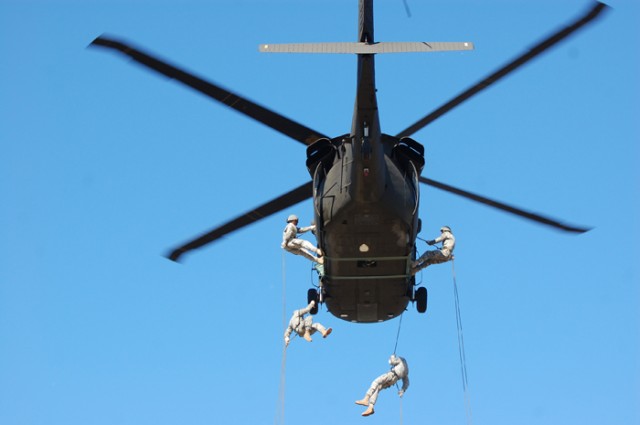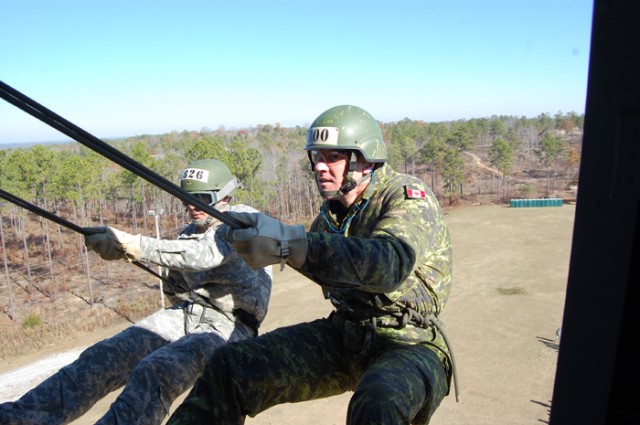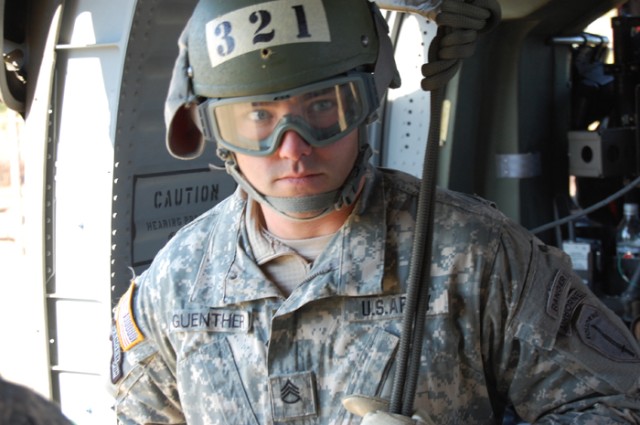FORT BENNING, Ga. (Dec. 10, 2010) - "The toughest 11 days in the Army" is a common phrase among students at Fort Benning's Air Assault School.
"It's one of the most physical schools in the Army other than Ranger School," said Staff Sgt. James Hickman, a senior instructor for the course.
The first day of training, also known as "zero" day, whittled the 350 students who vied for a slot in the course down to 240. And of those, only 228 remained nine days later.
The National Guard's Fort Benning-based Warrior Training Center conducts the course, which includes three phases of instruction involving rotary wing aircraft. Students are trained and tested in combat air assault operations, rigging and sling load operations and rappelling from a helicopter.
They learn aircraft safety, aero-medical evacuation procedures and pathfinder operations in addition to completing two ruck marches for a total of 18 miles.
"It's mental and labor intensive. The goal is to prepare them for combat situations," Hickman said.
1st Sgt. John Ites, of the WTC's B Company, got a fresh look at the training Wednesday.
Ites is a student in the current course.
"I'm learning a lot about how the course operates and what kind of changes can be implemented after I graduate. There will be some minor changes," he said.
Ites said the instructors are enjoying the reversal of roles.
"They are having fun with it. But I tell them 'you have me for 11 days, I have you for a year,'" he joked. "The toughest part for me personally is getting smoked by these young guys - all the extracurricular PT."
Ites said the point in the course where they typically lose the most students is during the sling load testing in phase two. The students must identify three out of four deficiencies on a rigged vehicle or load in less than two minutes. They get two attempts. If they don't pass, they fail the course.
"There are people that just can't move fast enough and are not looking for what they need to look at," he said.
Phase one's "zero" day obstacle course is also an event that sees a lot of failures, he said, with an average of 40-50 failures per cycle. The students complete a two-mile run and then hit a nine-obstacle course.
The course is capped at 240 students, so the obstacle course helps weed out those who aren't physically prepared for it, he said.
Ites' course included several international students from Canada, Sweden and Argentina. By the final day, one of 11 females who began the course remained.
Spc. Madelaine Butler, an administrative assistant with Fort Stewart's 385th Military Police Company, said when the opportunity came up to attend the course she didn't hesitate.
"I push paper all day so this is way different then what I usually do. I didn't have a lot of opportunities when I was a kid, so I want to do everything. I don't think people should judge me by my job title or being female," she said.
Canadian Warrant Officer Gewan Seeloch, of the 3rd Royal Canadian Regiment in Ontario, was part of the largest contingent of international students in the course. Of the 48 who started, only 29 reached the final phase.
Seeloch, a platoon sergeant, said the regiment is working toward establishing ground-level air assault skills and has no equivalent to the course offered by the U.S. Army.
Seeloch said he's been deployed in combat and participated in air assault operations.
"A lot of our younger soldiers have never been in an aircraft before and didn't know what it was capable of - this is good familiarization for them," he said.
Staff Sgt. Daniel Guenther, a Ranger instructor with 4th Ranger Training Battalion, was a walk-on to the course and said the most stressful part was the sling load testing.
"I was sweating it a little bit," he said.
Guenther said he believes the reason the sling load is so heavily stressed is because of the outcome if done incorrectly.
"If someone didn't hook it up correctly or the load was too heavy for the aircraft ... you could have a Humvee coming through your roof," he said.
The course graduates today.
Interested in attending'
Students arriving at the Air Assault School should be in good physical condition. Potential students should be able to score a minimum of 240 points on the Army Physical Fitness Test. Soldiers arriving able to meet the before mentioned standard will have little difficulty with the physical aspects of the course. Students should also be able to climb a vertical rope to a height of 16 feet.
Download the success guide
You can download packing lists, the air assault success guide and a six-week training program to prepare for the course by visiting https://www.benning.army.mil/wtc/wtc/b/aaslt/index.htm.
A heat acclimation guide for students attending training in hot weather is also available.






Social Sharing